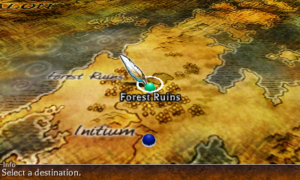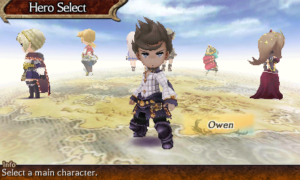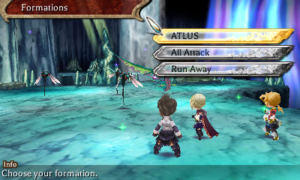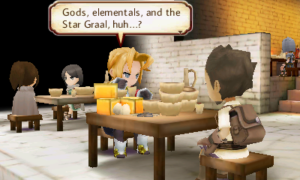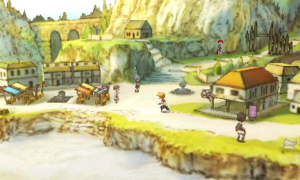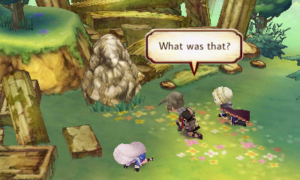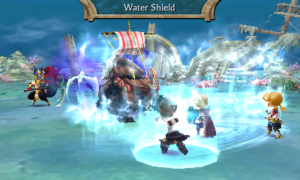The success of Bravely Default came as a surprise to no one, least of all RPG hungry portable gamers who are aware, unlike certain big name Japanese studios, that old style 80s JRPGs are starting to come back into vogue. While Square may still be learning that people want this type of game, their competitors, such as Atlus and NIS, are all too happy to beat them to the punch by meeting the consumer demand they have chosen to ignore. Whether it’s with obscure dungeon crawlers or pantsu-sniffing RPG ecchi-fests, the retro pool is getting deeper, on both consoles as well as PCs.
The latest of these retro-inspired, hardcore JRPGs to make the jump to the western market is Furyu’s The Legend of Legacy, an ambitious RPG that was designed by ex Level-5 and Square-Enix staffers. With such a strong pedigree, you’d expect the game to at least be somewhat pleasurable…but making a quality RPG isn’t the same as building a house or baking a cake. An RPG is about balance, finesse, putting the right rewards and progression systems in and making sure it is spread out thin enough to keep the player excited to go forward, but just challenging enough to keep that carrot dangled a few inches out of reach every time they go grabbing for it.
Confusing metaphors aside, I can tell you that The Legend of Legacy is not one of these finely-tuned RPGs. As talented as Furyu may be, I think they made the same mistake with this RPG as Level-5 did with “Your HP tops off at 999” Rogue Galaxy. And “Pokemon, but with more grinding” Ni no Kuni. And…well, maybe I should just start at the beginning.
The Legend of Legacy uses a system of leveling and skill accrual that is borrowed from the classic SaGa games of old. For those who are unfamiliar with the SaGa games, their character progression mechanism was such that you didn’t gain levels and instead gained parameters and abilities based on how you acted in combat.
Getting hit would increase your hit points, using magic would increase mana points, successfully attacking would increase strength and weapon use would unlock new abilities centered around the weapon you held in combat. Though somewhat inelegant, it worked well enough to become the basis for several JRPGs, including quite a few indies as well. Everything from 1998’s Muira Warrior to Square-Enix’s own Chrono Cross used variants of the “SaGa-style” of character progression, and it usually worked.
Usually.
Speaking as an immense fan of SaGa Frontier 1 and 2 on the PSX, I love the way that the SaGa-based progression mechanic negates the need to grind levels. Sure, I love grinding (I’m a Shin Megami Tensei fan, so that’s a given) but the biggest draw of those level-less character advancement systems is that you don’t have to bulk up for hours on end to get the stats needed to move forward.
As you encounter higher level enemies, the likelihood of learning advanced techniques and gaining large stat bonuses goes up, creating a nice balance between “I’m getting one-shotted” and “I’m one-shotting the enemies”. Go play Chrono Cross or Saga Frontier and blaze through them without leveling if you don’t believe me. The silky-smooth and gradual ascent to those game’s climaxes is almost entirely devoid of agonizing grinds.
The Legend of Legacy, however, is not.
Right from the start, you’ll find the odds stacked against you and probably experience quite a few party wipe-outs. I know that I did, and it only served to anger me enough to spend all night grinding with the same three characters until I could make it to the first boss in a healthy enough state to stand a chance.
The downside to that was me having ignored all of my other party members and having to spend *that much time* with them as well, eventually grinding them up to a respectable level to where they wouldn’t get one-shotted. Let’s just say that Pegasus formation the game starts you with that has one of your characters tank with a shield saved my rear-end more times than I’d care to admit.
To be fair, while you do need to grind fairly heavily in the first 10 hours or so after starting the game, it does become a bit more bearable after you smack down the first shrine’s boss. After that point, you no longer need to grind too much. Mainly because you start getting forced to wade through gigantic trash mobs in astonishingly repetitive and confusing dungeons.
Earlier in the review I mentioned that grinding can be fun if you spread the content thin enough to keep the experience fresh. New enemies, new environments, new spells and weapons…these all make the grinding fun. Some games elect to have rare gear drop from random mobs to aid in this mechanic, while others (like Shin Megami Tensei) drop new skills and abilities on you like F-bombs at Shea Stadium. No matter what method they use, they always keep something new right in front of you to make that grind feel worthwhile. There’s a reason and an incentive to grind, and that’s the trick to keeping any RPG exciting.
The reason I bring this up is because The Legend of Legacy has no such incentives.
Weapons are found extremely infrequently and are only in chests or bought for high prices in town from a merchant whose stock changes about as infrequently as American schools change their history textbooks. Skills that you unlock are mostly just higher damage variants of previous attacks, save for a few that inflict status ailments. Spells are gained through shards that require a contract you must lift off bosses and can only equip two at a time. Enemies are mostly palette-swapped cut-and-paste nuisances. Dungeons use frequently recycled assets which make them incredibly uninteresting…
Basically, every new bit of content that would make that grind feel bearable is spread *so* thin and trickled out *so* slowly and inefficiently that fighting 6-man trash mobs every 30 seconds while you bumble through very cramped corridors in copy-pasted dungeons feels about as exciting and rewarding as working the late-night shift at a burger joint. Though at least in that case, the agony would be blunted by you receiving a paycheck.
I should have expected the game to be small when the size of the download after receiving my review code was *one third* the total block size of Bravely Default. Not to compare the two games again, but it doesn’t bode well when your game is less than half the size of a game that already uses a fair bit of asset recycling.
The saving grace for the game could have been its story. I say could have been since, at first glance, it looks as if The Legend of Legacy would have one. Sadly, that’s not really the case. Though you can select your starting character and you can ask the King if he’s dating anyone before he sends you off to find artifacts for him, there isn’t much more than that. The majority of the story is told through poetry given to you by ancient monuments or spoken during short intermissions. It tries to be classy and artful in the way that, say, Lost Odyssey was, but it didn’t work on me. I could make no sense of it even 20 hours in and all I could do was think how banal the combat was.
That’s the biggest crime too, since an unimaginative combat engine is a sure-fire way to kill a gamer’s interest.
When I first played The Legend of Legacy, I was told the game had, quote, “Unforgiving combat” and that it would test my party management skills. Unfortunately, that wasn’t true. The combat is incredibly straight forward with very little strategy needed beyond “Make sure you heal” and “double up on enemies with a mid-level attack to conserve resources”. Granted, as I said earlier, that first 10 hours or so will require some delicate finagling, but after that it’s all about basic 1980s JRPG common sense. They do try to add a field-effect elemental system (again, similar to Chrono Cross) but you can ignore it about 90% of the time.
When you combine the bland combat with the copy pasted dungeons, poor monster variation, lack of incentives, tortoise-like progression and almost non-existent plot, you get a game that makes me question whether the developers even bothered playing it after compiling their code.
Most of the game is spent running through dungeons looking for chests and trying to clear them so you can sell the auto-map information to the merchant for easy gold. What’s sad is that it isn’t very long until you begin opening up dungeons that have in upwards of a dozen or so interconnected screens that all look alike with the same enemies crowding their corridors.
What really stings is that the majority of them are just there to act as the machine that spits out *another* dungeon location. You can imagine my frustration when I waded through trash mobs for 5 hours straight (without saving, mind you) only to hit the end of a dungeon and have a scripted event fire off that merely opened another dungeon just like it elsewhere on the map.
I don’t want to come down hard on The Legend of Legacy, but it seems like it follows that same Level-5 trend of being a game that will only appeal to a very small niche of gamer who expects something completely different from the genre than everyone else. If you don’t mind grind-heavy slogfests with middling rewards, painfully slow progression and the kind of asset re-use and enemy palette-swapping that would rival the first four NES Dragon Quest games, you may find something to enjoy here.
For the rest of us, I would recommend getting your SaGa-style RPG fix by playing Final Fantasy Legend 2 on that old Gameboy you’re hopefully keeping around.
The Legend of Legacy was reviewed on the Nintendo 3DS using a code provided by Atlus. You can find additional information about Niche Gamer’s review/ethics policy here.
The Verdict 5.5
The Good
- SaGa style leveling
- Beautiful character designs
The Bad
- Uninteresting combat
- Heavy asset recycling
- Large, repeating dungeons with little to no variation
- Poor incentives to moving forward
- Unbalanced gameplay often requires heavy grinding

